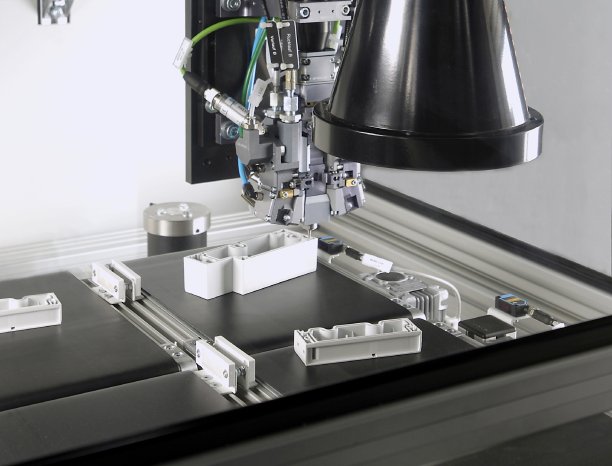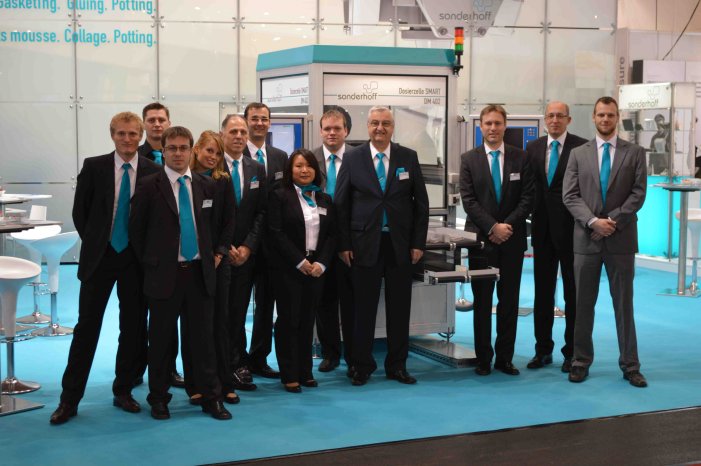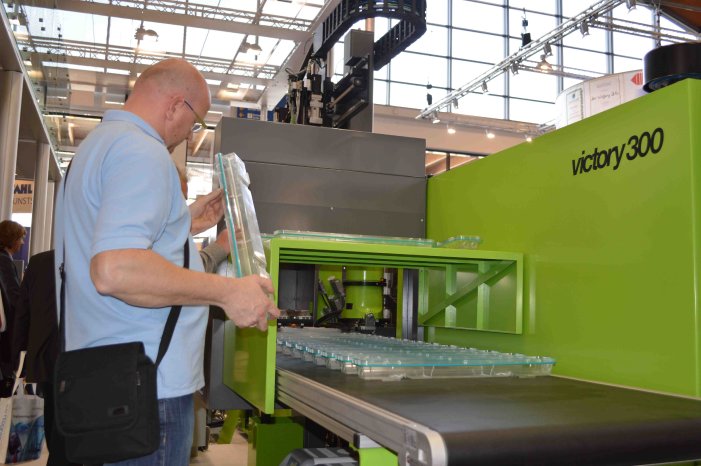The Sonderhoff group of companies, the system supplier for sealing material, mixing and dosing machines as well as contract manufacturing service, could also benefit from the optimistic mood prevailing on the Fakuma fair, as did many of the 1,700 exhibitors from 37 countries this year. Sonderhoff registered more trade show leads than last year. In particular discussions on concrete projects have increased which led to conclusion of sales or initiation of new projects.
The automation specialist Sonderhoff Engineering from Hörbranz /Austria with its newly developed dispensing cell SMART - DM 402 could demonstrate to the professional visitors that due to the optionally equipped automatic part recognition in the dispensing cell the fully automatic sealing process with Sonderhoff foam gasket and potting products is also possible in the case of a chaotic parts feed. In various discussions at the booth it became clear that Sonderhoff exactly meets the customers' requirements on highest possible flexibility and process efficiency. The great advantage of the automatic component recognition is that customers can save on investment costs for parts' holding fixtures on the mixing and dosing system and save themselves long installation times.
With high-performance optics, permanently installed in the dispensing cell, the intelligent image recognition system verifies the arbitrary position of the components on the transfer conveyor and automatically recognizes the different component sizes and shapes. In order to capture the image data, the conveyor belt stops for a short period of time and sends the component-specific image data to the 3-axis linear robot control. The dosing contour program for the different component shapes to be processed is adjusted accordingly and the contouring control of the 3-axis linear robot is corrected in such a way that the foaming or potting is always carried out precisely at the right place on the component.
The Sonderhoff 3-axis linear robot can scan components with a traversing range of up to 500 x 500 mm (width x depth) and up to a parts height of 200 mm at the most. In doing so, the mixing head of the SMART dispensing cell is positioned with a repeat accuracy of +/- 0.05 mm above the component so that the sealing material can be precisely applied directly onto the component or in a groove by the mixing head dosing nozzle. A maximum acceleration of 5 m/s² in component radii is possible with the Sonderhoff linear robot.
The material used for a polyurethane- or silicone-based foam gasket or potting from the Sonderhoff Chemicals product range is processed by the dispensing cell SMART with a consistently high production quality, with a stable material consistency and constant seal dimensions. The dispensing cell SMART - DM 402 can be equipped with the mixing heads MK 600, MK 625 or MK 650 for micro-seals (up to 2 mm). The discharge performance of the mixing head is between 0.05 and 100.0g/s. The system can process viscosities of the sealing material between 300 and 2 million mPas without problems and the mixing ratio can be set continuously from 100:1 to 1:100.
Due to its compact design and small size, the dispensing cell SMART - DM 402 can be easily integrated into existing production concepts. With overall dimension of 1200 x 1200 x 2300 mm (width x depth x height) only minimal space is required. This mixing and dosing cell from Sonderhoff should be interesting in particular for customers from the electronics, telecommunications and IT industry as well as for medical devices manufacturers who need to seal especially small components and system components. In the model of the dispensing cell SMART, equipped with the mixing head MK 650, very small foam gaskets, so-called micro-seals, can be applied with a discharge performance of up to 0.1 g/s. In the case of the potting of electronics components micro-potting with a discharge amount even as low as 0.05 g/s can be realized.
For many plastics processing companies, production orders with small batch sizes but a high variety of components become more and more of a challenge. In this case, fully automatic manufacturing processes often make no sense as the constant change of materials and the frequent replacement and installation of the parts holding fixtures lead to high machine set-up times which increase the costs per unit. Companies have to react to this in a flexible way in order to remain competitive. However, a high variety and constantly changing component sizes are no problem for the dispensing cell SMART - DM 402 with its optical component recognition. On the contrary, with the SMART - DM 402 system no machine set-up times occur for a high variety of components in one production order and thus the costs per unit decrease.
Efficient and cost saving production through process integration with the MOLD'n SEAL procedures
In addition to its own trade fair presentation at Fakuma 2012 Sonderhoff as ENGEL system partner also participated at the booth of ENGEL AUSTRIA, the renowned manufacturer of injection moulding machines from Schwertberg/Austria. Sonderhoff presents there the MOLD'n SEAL procedures, a system solution for intelligent process integration interlinking the ENGEL machine victory 1350/300 tech and the dispensing machine DM 402 from Sonderhoff Engineering. MOLD'n SEAL combines two formerly separated processes injection moulding and foam gasket application from the viewpoint of high efficiency and product quality in one production step.
The complete production cell including mixing and dosing system, handling robot and transfer conveyor belt requires only a footprint of 24 square metres. In this cell the fair visitors saw the injection moulding production of housings for moisture-proof lamps, immediately followed by foam gasket application with sealant based on polypropylene from Sonderhoff Chemicals.
The lamp housing is precisely moved according to its contour by the ENGEL easix 6-axis robot under the mixing head MK 600 from Sonderhoff. Through the high movement constancy and repeat accuracy of the robot and the precise mixing and dosing technology from Sonderhoff Engineering the foam gasket could be applied in the groove of the component which is only few millimetres wide. Within 55 seconds per injection moulding cycle, in an eight hour shift, without interruption more than 523 luminaire housings were injection moulded, removed from the mould, foamed, and placed on a discharge belt for curing and further processing.
The visitors at Fakuma were assured that process integration of injection moulding and foam gasket application can be done with MOLD'n SEAL in one production step, realizing with it significant savings of time, energy and overall costs. By using the MOLD'n SEAL procedures higher production output at lower cost per unit is possible.





